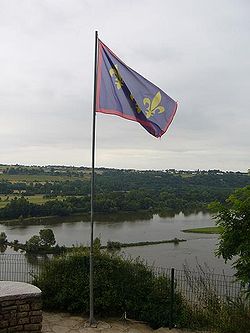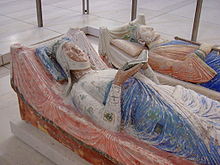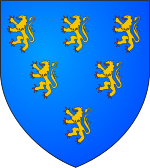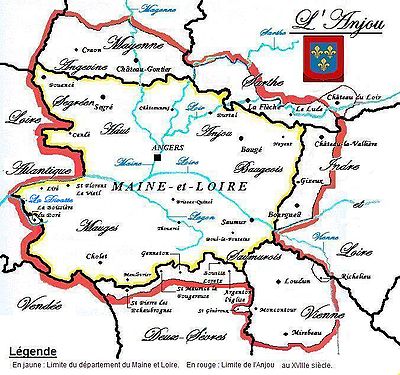- Anjou
-
For other uses, see Anjou (disambiguation).
Anjou 
Flag
Coat of armsCountry France Time zone CET Rulers 870–98, Ingelger
1480–81, Charles IV of AnjouAnjou (French pronunciation: [ɑ̃ʒu]) is a former county (c. 880), duchy (1360) and province centred on the city of Angers in the lower Loire Valley of western France. It corresponds largely to the present-day département of Maine-et-Loire. Its traditional Latin name is Andegavia.
Contents
History
Gauls, Romans, and Franks
Its political origin is traced to the ancient Gallic state of the Andes, on the lines of which was organized, after the conquest by Julius Caesar, the Roman civitas of the Andecavi. This was afterward preserved as an administrative district under the Franks with the name first of pagus, then of comitatus, or countship of Anjou. This countship, the extent of which seems to have been practically identical with that of the ecclesiastical diocese of Angers, occupied the greater part of what is now the départment of Maine-et-Loire, further embracing, to the north, Craon, Candé, Bazouges (Château-Gontier), Le Lude, and to the east, Château-la-Vallière and Bourgueil, while to the south, on the other hand, it included neither the present town of Montreuil-Bellay, nor Vihiers, Cholet, Beaupréau, nor the whole district lying to the west of the Ironne and Thouet, on the left bank of the Loire, which formed the territory of the Mauges. It was bounded on the north by the countship of Maine, on the east by that of Touraine, on the south by that of Poitiers and by the Mauges, on the west by the countship of Nantes.
From the outset of the reign of Charles the Bald, the integrity of Anjou was seriously menaced by a twofold danger: from Brittany (on the west side boundary) and from Normandy (on the north side boundary). Lambert, a former count of Nantes, after devastating Anjou in concert with Nominoé, duke of Brittany, had by the end of the year 851 succeeded in occupying all the western part as far as the Mayenne. The principality, which he thus carved out for himself, was occupied, on his death, by Erispoé, duke of Brittany; by him it was handed down to his successors, in whose hands it remained until the beginning of the 10th century.
All this time the Normans had not ceased ravaging the country; a brave man was needed to defend it, and finally towards 861, Charles the Bald entrusted it to Robert the Strong, but Robert met his death in 866 in a battle against the Normans at Brissarthe. Hugh the Abbot succeeded him in the countship of Anjou as in most of his other duties, and on his death (886) it passed to Odo, the eldest son of Robert the Strong, who, on his accession to the throne of France (888), probably handed it over to his brother Robert. In any case, during the last years of the 9th century, in Anjou as elsewhere the power was delegated to a viscount, Fulk the Red (mentioned under this title after 898), son of a certain Ingelgerius.
The Fulks
In the second quarter of the 10th century Fulk the Red had already usurped the title of count, which his descendants kept for three centuries. He was succeeded first by his son Fulk II the Good (941 or 942 – c. 960), and then by the son of the latter, Geoffrey I Grisegonelle (Greytunic) (c. 960 – 21 July 987), who inaugurated a policy of expansion, having as its objects the extension of the boundaries of the ancient countship and the reconquest of those parts of it which had been annexed by the neighbouring states; for, though western Anjou had been recovered from the dukes of Brittany since the beginning of the 10th century, in the east all the district of Saumur had already by that time fallen into the hands of the counts of Blois and Tours.
Geoffrey Greytunic succeeded in making the count of Nantes his vassal, and in obtaining from the duke of Aquitaine the concession in fief of the district of Loudun. Moreover, in the wars of King Lothaire against the Normans and against the emperor Otto II he distinguished himself by feats of arms which the epic poets were quick to celebrate.
His son Fulk III Nerra (21 July 987 – 21 June 1040) found himself confronted on his accession with a coalition of Odo I, count of Blois, and Conan I of Rennes. The latter having seized upon Nantes, of which the counts of Anjou held themselves to be suzerains, Fulk Nerra came and laid siege to it, routing Conan's army at the battle of Conquereuil (27 June 992) and re-establishing Nantes under his own suzerainty. Then turning his attention to the count of Blois, he proceeded to establish a fortress at Langeais, a few miles from Tours, from which, thanks to the intervention of the king Hugh Capet, Odo failed to oust him.
On the death of Odo I, Fulk seized Tours (996); but King Robert the Pious turned against him and took the town again (997). In 1016 a fresh struggle arose between Fulk and Odo II, the new count of Blois. Odo II was utterly defeated at Pontlevoy (6 July 1016), and a few years later, while Odo was besieging Montboyau, Fulk surprised and took Saumur (1026).
Finally, the victory gained by Geoffrey Martel (21 June 1040 – 14 November 1060), the son and successor of Fulk, over Theobald III, count of Blois, at Nouy (21 August 1044), assured to the Angevins the possession of the countship of Touraine. At the same time, continuing in this quarter also the work of his father (who in 1025 took prisoner Herbert Wakedog and only set him free on condition of his doing him homage), Geoffrey succeeded in reducing the countship of Maine to complete dependence on himself. During his father's life-time he had been beaten by Gervais de Château-du-Loir, bishop of Le Mans (1038), but later (1047 or 1048) succeeded in taking the latter prisoner, for which he was excommunicated by Pope Leo IX at the council of Reims (October 1049). In spite, however, of the concerted attacks of William the Bastard (the Conqueror), duke of Normandy, and Henry I of France, he was able in 1051 to force Maine to recognize his authority, though failing to revenge himself on William.
On the death of Geoffrey Martel (14 November 1060) there was a dispute as to the succession. Geoffrey Martel, having no children, had bequeathed the countship to his eldest nephew, Geoffrey III the Bearded, son of Geoffrey, count of Gâtinais and of Ermengarde, daughter of Fulk Nerra. But Fulk le Réchin (the Cross-looking), brother of Geoffrey the Bearded, who had at first been contented with an appanage consisting of Saintonge and the châtellenie of Vihiers, having allowed Saintonge to be taken in 1062 by the duke of Aquitaine, took advantage of the general discontent aroused in the countship by the unskilful policy of Geoffrey to make himself master of Saumur (25 February 1067) and Angers (4 April), and cast Geoffrey into prison at Sablé. Compelled by the papal authority to release him after a short interval and to restore the countship to him, he soon renewed the struggle, beat Geoffrey near Brissac and shut him up in the castle of Chinon (1068). In order, however, to obtain his recognition as count, Fulk IV Réchin (1068 – 14 April 1109) had to carry on a long struggle with his barons, to cede Gâtinais to King Philip I, and to do homage to the count of Blois for Touraine. On the other hand, he was successful on the whole in pursuing the policy of Geoffrey Martel in Maine: after destroying La Flèche, by the peace of Blanchelande (1081), he received the homage of Robert Curthose ("Courteheuse"), son of William the Conqueror, for Maine. Later, he upheld Elias, lord of La Flèche, against William Rufus, king of England, and on the recognition of Elias as count of Maine in 1100, obtained for Fulk V the Young, his son by Bertrade de Montfort, the hand of Eremburge, Elias's daughter and sole heiress.
Fulk V the Young (14 April 1109–1129) succeeded to the countship of Maine on the death of Elias (11 July 1110); but this increase of Angevin territory came into such direct collision with the interests of Henry I of England, who was also duke of Normandy, that a struggle between the two powers became inevitable. In 1112 it broke out, and Fulk, being unable to prevent Henry I from taking Alençon and making Robert, lord of Bellême, prisoner, was forced, at the treaty of Pierre Pecoulée, near Alençon (23 February 1113), to do homage to Henry for Maine. In revenge for this, while Louis VI was overrunning the Vexin in 1118, he routed Henry's army at Alençon (November), and in May 1119 Henry demanded a peace, which was sealed in June by the marriage of his eldest son, William the Aetheling, with Matilda, Fulk's daughter. William the Aetheling having perished in the wreck of the White Ship (25 November 1120), Fulk, on his return from a pilgrimage to the Holy Land (1120–1121), married his second daughter Sibyl, at the instigation of Louis VI, to William Clito, son of Robert Curthose, and a claimant to the duchy of Normandy, giving her Maine for a dowry (1122 or 1123). Henry I managed to have the marriage annulled, on the plea of kinship between the parties (1123 or 1124). But in 1127 a new alliance was made, and on 22 May at Rouen, Henry I betrothed his daughter Matilda, widow of the emperor Henry V, to Geoffrey the Handsome, son of Fulk, the marriage being celebrated at Le Mans on 2 June 1129. Shortly after, on the invitation of Baldwin II of Jerusalem, Fulk departed to the Holy Land for good, married Melisinda, Baldwin's daughter and heiress, and succeeded to the throne of Jerusalem (14 September 1131). His eldest son, Geoffrey V the Handsome or "Plantagenet", succeeded him as count of Anjou (1129 – 7 September 1151).
The Plantagenets
From the first Geoffrey Plantagenet tried to profit by his marriage and, after the death of Henry I (1 December 1135), laid the foundation of the conquest of Normandy by a series of campaigns: about the end of 1135 or the beginning of 1136 he entered that country and rejoined his wife, the countess Matilda, who had received the submission of Argentan, Domfront and Exmes. Having been abruptly recalled into Anjou by a revolt of his barons, he returned to the charge in September 1136 with a strong army, including in its ranks William, duke of Aquitaine, Geoffrey, count of Vendôme, and William Talvas, count of Ponthieu, but after a few successes was wounded in the foot at the siege of Le Sap (1 October) and had to fall back.
In May 1137 began a fresh campaign in which he devastated the district of Hiémois (round Exmes) and burnt Bazoches. In June 1138, with the aid of Robert of Gloucester, Geoffrey obtained the submission of Bayeux and Caen; in October he devastated the neighbourhood of Falaise; finally, in March 1141, on hearing of his wife's success in England, he again entered Normandy, when he made a triumphal procession through the country. Town after town surrendered: in 1141, Verneuil, Nonancourt, Lisieux, Falaise; in 1142, Mortain, Saint-Hilaire, Pontorson; in 1143, Avranches, Saint-Lô, Cérences, Coutances, Cherbourg; in the beginning of 1144 he entered Rouen, and on 19 January received the ducal crown in its cathedral. Finally, in 1149, after crushing a last attempt at revolt, he handed over the duchy to his son Henry Curtmantle, who received the investiture at the hands of the king of France.
All the while that Fulk the Young and Geoffrey the Handsome were carrying on the work of extending the countship of Anjou, they did not neglect to strengthen their authority at home, to which the unruliness of the barons was a menace. As regards Fulk the Young we know only a few isolated facts and dates: about 1109 Doué and L'Île Bouchard were taken; in 1112 Brissac was besieged, and about the same time Eschivard of Preuilly subdued; in 1114 there was a general war against the barons who were in revolt, and in 1118 a fresh rising, which was put down after the siege of Montbazon: in 1123 the lord of Doué revolted, and in 1124 Montreuil-Bellay was taken after a siege of nine weeks. Geoffrey the Handsome, with his indefatigable energy, was eminently fitted to suppress the coalitions of his vassals, the most formidable of which was formed in 1129. Among those who revolted were Guy IV of Laval, Giraud I of Montreuil-Bellay, the viscount of Thouars, the lords of Mirebeau, Amboise, Partbenay and Sablé. Geoffrey succeeded in beating them one after another, razed the keep of Thouars and occupied Mirebeau.
Another rising was crushed in 1134 by the destruction of Cand and the taking of L'Île Bouchard. In 1136, while the count was in Normandy, Robert III of Sablé put himself at the head of the movement, to which Geoffrey responded by destroying Briollay and occupying La Suze, and Robert of Sable himself was forced to beg humbly for pardon through the intercession of the bishop of Angers. In 1139 Geoffrey took Mirebeau, and in 1142 Champtoceaux, but in 1145 a new revolt broke out, this time under the leadership of Elias, the count's own brother, who, again with the assistance of Robert of Sable, laid claim to the countship of Maine. Geoffrey took Elias prisoner, forced Robert of Sable to beat a retreat, and reduced the other barons to reason. In 1147 he destroyed Doue and Blaison. Finally in 1150 he was checked by the revolt of Giraud, lord of Montreuil-Bellay: for a year he besieged the place until it had to surrender: he then took Giraud prisoner and only released him on the mediation of the king of France.
Thus, on the death of Geoffrey the Handsome (7 September 1151), his son Henry found himself heir to a great empire, strong and consolidated, to which his marriage with Eleanor of Aquitaine (May 1152) further added Aquitaine.
At length on the death of King Stephen, Henry was recognised as king of England (19 December 1154), as agreed in the Treaty of Wallingford. But then his brother Geoffrey, who had received as appanage the three fortresses of Chinon, Loudun and Mirebeau, tried to seize upon Anjou, on the pretext that, by the will of their father, Geoffrey the Handsome, all the paternal inheritance ought to descend to him, if Henry succeeded in obtaining possession of the maternal inheritance. On hearing of this, Henry, although he had sworn to observe this will, had himself released from his oath by the pope, and hurriedly marched against his brother, from whom in the beginning of 1156 he succeeded in taking Chinon and Mirebeau; and in July he forced Geoffrey to give up even his three fortresses in return for an annual pension. Henceforward Henry succeeded in keeping the countship of Anjou all his life; for though he granted it in 1168 to his son Henry the Young King when the latter became old enough to govern it, he absolutely refused to allow him to enjoy his power. After Henry II's death in 1189 the countship, together with the rest of his dominions, passed to his son Richard I of England, but on the death of the latter in 1199, Arthur of Brittany (born in 1187) laid claim to the inheritance, which ought, according to him, to have fallen to his father Geoffrey, fourth son of Henry II, in accordance with the custom by which "the son of the eldest brother should succeed to his father's patrimony." He therefore set himself up in rivalry with John Lackland, youngest son of Henry II, and supported by Philip Augustus of France, and aided by William des Roches, seneschal of Anjou, he managed to enter Angers (18 April 1199) and there have himself recognized as count of the three countships of Anjou, Maine and Touraine, for which he did homage to the king of France. King John soon regained the upper hand, for Philip Augustus having deserted Arthur by the treaty of Le Goulet (22 May 1200), John made his way into Anjou; and on 18 June 1200 was recognized as count at Angers. In 1202 he refused to do homage to Philip Augustus, who, in consequence, confiscated all his continental possessions, including Anjou, which was allotted by the king of France to Arthur. The defeat of the latter, who was taken prisoner at Mirebeau on the first of August 1202, seemed to ensure John's success, but he was abandoned by William des Roches, who in 1203 assisted Philip Augustus in subduing the whole of Anjou. A last effort on the part of John to possess himself of it, in 1214, led to the taking of Angers (17 June), but broke down lamentably at the battle of La Roche-aux-Moines (2 July), and the countship was attached to the crown of France.
Shortly afterwards it was separated from it again, when in August 1246 King Louis IX gave it as an appanage to his brother Charles, count of Provence, soon to become king of Naples and Sicily. Charles I of Anjou, engrossed with his other dominions, gave little thought to Anjou, nor did his son Charles II, the Lame, who succeeded him on 7 January 1285. On 16 August 1290, the latter married his daughter Margaret to Charles of Valois, son of Philip III the Bold, giving her Anjou and Maine for dowry, in exchange for the kingdoms of Aragon and Valentia and the countship of Barcelona given up by Charles. Charles of Valois at once entered into possession of the countship of Anjou, to which Philip IV, the Fair, in September 1297, attached a peerage of France. On 16 December 1325, Charles died, leaving Anjou to his eldest son Philip of Valois, on whose recognition as king of France (Philip VI) on 1 April 1328, the countship of Anjou was again united to the crown.
On 17 February 1332, Philip VI bestowed it on his son John the Good, who, when he became king in turn (22 August 1350), gave the countship to his second son Louis I, raising it to a duchy in the peerage of France by letters patent of 25 October 1360. Louis I, who became in time count of Provence and king of Naples, died in 1384, and was succeeded by his son Louis II, who devoted most of his energies to his kingdom of Naples, and left the administration of Anjou almost entirely in the hands of his wife, Yolande of Aragon. On his death (29 April 1417) she took upon herself the guardianship of their young son Louis III, and in her capacity of regent defended the duchy against the English. Louis III, who also succeeded his father as king of Naples, died on 15 November 1434, leaving no children. The duchy of Anjou then passed to his brother René, second son of Louis II and Yolande of Aragon, and king of Naples and Sicily.
In the Kingdom of France
Map of Anjou in the 18th century.
In yellow: the Maine-et-Loire current département.
In red: the former border of AnjouUnlike his predecessors, who had rarely stayed long in Anjou, René from 1443 onwards paid long visits to it, and his court at Angers became one of the most brilliant in the kingdom of France. But after the sudden death of his son John in December 1470, René, for reasons which are not altogether clear, decided to move his residence to Provence and leave Anjou for good. After making an inventory of all his possessions, he left the duchy in October 1471, taking with him the most valuable of his treasures. On 22 July 1474 he drew up a will by which he divided the succession between his grandson René II of Lorraine and his nephew Charles II, count of Maine. On hearing this, King Louis XI, who was the son of one of King René's sisters, seeing that his expectations were thus completely frustrated, seized the duchy of Anjou. He did not keep it very long, but became reconciled to René in 1476 and restored it to him, on condition, probably, that René should bequeath it to him. However that may be, on the death of the latter (10 July 1480) he again added Anjou to the royal domain.
Later, King Francis I again gave the duchy as an appanage to his mother, Louise of Savoy, by letters patent of 4 February 1515. On her death, in September 1531, the duchy returned into the king's possession. In 1552 it was given as an appanage by Henry II to his son Henry of Valois, who, on becoming king in 1574, with the title of Henry III, conceded it to his brother Francis, duke of Alençon, at the treaty of Beaulieu near Loches (6 May 1576). Francis died on 10 June 1584, and the vacant appanage definitively became part of the royal domain.
At first Anjou was included in the gouvernement (or military command) of Orléanais, but in the 17th century was made into a separate one. Saumur, however, and the Saumurois, for which King Henry IV had in 1589 created an independent military governor-generalship in favour of Duplessis-Mornay, continued till the Revolution to form a separate gouvernement, which included, besides Anjou, portions of Poitou and Mirebalais. Attached to the généralité (administrative circumscription) of Tours, Anjou on the eve of the Revolution comprised five êlections (judicial districts):--Angers, Baugé, Saumur, Château-Gontier, Montreuil-Bellay and part of the êlections of La Flèche and Richelieu. Financially it formed part of the so-called pays de grande gabelle, and comprised sixteen special tribunals, or greniers à sel (salt warehouses):--Angers, Baugé, Beaufort, Bourgueil, Candé, Château-Gontier, Cholet, Craon, La Flèche, Saint-Florent-le-Vieil, Ingrandes, Le Lude, Pouancé, Saint-Rémy-la-Varenne, Richelieu, Saumur. From the point of view of purely judicial administration, Anjou was subject to the parlement of Paris; Angers was the seat of a presidial court, of which the jurisdiction comprised the sénéchaussées of Angers, Saumur, Beaugé, Beaufort and the duchy of Richelieu; there were besides presidial courts at Château-Gontier and La Flèche. When the Constituent Assembly, on 26 February 1790, decreed the division of France into départments, Anjou and the Saumurois, with the exception of certain territories, formed the départment of Maine-et-Loire, as at present constituted.
Principal sources
The history of Anjou may be told partly with the aid of the chroniclers of the neighbouring provinces, especially those of Normandy (William of Poitiers, William of Jumièges, Ordericus Vitalis) and of Maine (especially Actus pontificum cenomannis in urbe degentium). For the 10th, 11th and 12th centuries especially, there are some important texts dealing entirely with Anjou. The most important is the chronicle called Gesta consulum Andegavorum, of which only a poor edition exists (Chroniques des comtes d'Anjou, published by Marchegay and Salmon, with an introduction by E. Mabille, Paris, 1856–1871, collection of the Société de l'histoire de France). See also with reference to this text Louis Halphen, Êtude sur les chroniques des comtes d'Anjou et des seigneurs d'Amboise (Paris, 1906). The above may be supplemented by some valuable annals published by Louis Halphen, Recueil d'annales angevines et vendómoises (Paris, 1903), (in the series Collection de textes pour servir à l'étude et à l'enseignement de l'histoire). For further details see Auguste Molinier, Les Sources de l'histoire de France (Paris, 1902), ii. 1276–1310, and the book of Louis Halphen mentioned below.
Works
The Art de vérifier les dates contains a history of Anjou which is very much out of date, but has not been treated elsewhere as a whole. The 11th century only has been treated in detail by Louis Halphen, in Le Comté d'Anjou au XIe siècle (Paris, 1906), which has a preface with bibliography and an introduction dealing with the history of Anjou in the 10th century. For the 10th, 11th and 12th centuries, a good summary will be found in Kate Norgate, England under the Angevin Kings (2 vols., London, 1887). On René of Anjou, there is a book by A. Lecoy de La Marche, Le Roi René (2 vols., Paris, 1875). Lastly, the work of Célestin Port, Dictionnaire historique, géographique et biographique de Maine-et-Loire (3 vols., Paris and Angers, 1874–1878), and its small volume of Préliminaires (including a summary of the history of Anjou), contain, in addition to the biographies of the chief counts of Anjou, a mass of information concerning everything connected with Angevin history.
See also
- List of Counts and Dukes of Anjou
- Angevin Empire
- French wine
- Seneschal of Anjou
- D'Anjou Pear
Link
 This article incorporates text from a publication now in the public domain: Chisholm, Hugh, ed (1911). Encyclopædia Britannica (11th ed.). Cambridge University Press.
This article incorporates text from a publication now in the public domain: Chisholm, Hugh, ed (1911). Encyclopædia Britannica (11th ed.). Cambridge University Press.

 Historical Provinces of France
Historical Provinces of FranceProvinces Alsace • Angoumois • Anjou • Artois • Aunis • Auvergne • Basse-Navarre • Béarn • Beaujolais • Berry • Bourbonnais • Brittany • Burgundy • Champagne • Corsica • Dauphiné • Flanders and Hainaut • Foix • Forez • Franche-Comté • Gascony • Guyenne • Île-de-France • Languedoc • Limousin • Lorraine • Lyonnais • Maine • Marche • Montbéliard • Mulhouse • Nice • Nivernais • Normandy • Orléanais • Perche • Picardy • Poitou • Provence • Roussillon • Saintonge • Savoy • Touraine • Trois-Évêchés • Venaissin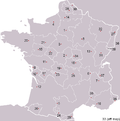 Categories:
Categories:- Former provinces of France
- Middle Ages
- Former countries in Europe
- Maine-et-Loire
Wikimedia Foundation. 2010.



